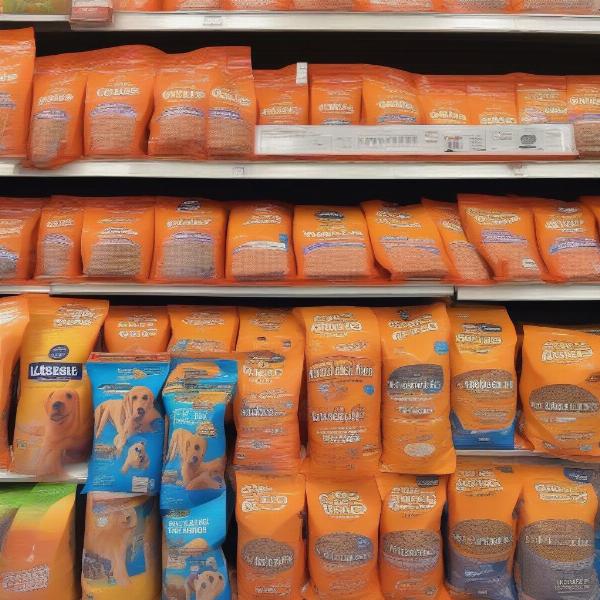Dog food packaged in an orange bag often catches the eye on pet store shelves. But what does this vibrant color choice signify about the food inside? Does it point to a specific brand, ingredient, or nutritional profile? This article will delve into the world of dog food in orange bags, exploring the potential meanings behind the packaging and offering valuable insights to help you choose the best nutrition for your canine companion.
What Does the Orange Bag Tell Us?
Unfortunately, the orange color of a dog food bag isn’t a universal indicator of any specific quality or ingredient. Unlike some colors used in pet food packaging, orange doesn’t have a standardized meaning. It’s primarily a marketing tactic designed to stand out and attract attention. So, while an orange bag might grab your eye, it doesn’t inherently tell you anything about the food’s quality.
 Orange Dog Food Bag on Shelf
Orange Dog Food Bag on Shelf
Looking Beyond the Color: Choosing the Right Dog Food
Instead of focusing on the bag’s color, concentrate on the information provided on the label. This is where you’ll find the crucial details about the food’s ingredients, nutritional value, and suitability for your dog’s age, breed, and health needs. Here’s what to look for:
- Ingredient List: The first ingredient should be a named meat source, like chicken, beef, or lamb. Avoid foods with vague terms like “meat by-products.”
- Guaranteed Analysis: This section lists the minimum percentages of crude protein, fat, fiber, and moisture. Compare these values across different brands to find a food that meets your dog’s nutritional requirements.
- Life Stage: Choose a food formulated for your dog’s specific life stage (puppy, adult, senior). Puppies and seniors have different nutritional needs than adult dogs.
- Breed Size: Some brands offer formulas specifically designed for small, medium, or large breeds. This can be helpful for addressing breed-specific health concerns.
- AAFCO Statement: Look for a statement from the Association of American Feed Control Officials (AAFCO) confirming that the food meets nutritional standards for complete and balanced nutrition.
Deciphering Dog Food Labels
Understanding dog food labels can be tricky. Manufacturers often use marketing language that can be confusing. For example, terms like “premium” or “natural” don’t have regulated definitions.
Always prioritize the ingredient list and guaranteed analysis over marketing claims. If you’re unsure which food is best for your dog, consult your veterinarian. They can recommend a diet that meets your dog’s specific needs.
Is There an Orange-Bagged Dog Food Brand You’re Looking For?
If you’re searching for a particular dog food in an orange bag, you might need to do some detective work. Try searching online using keywords like “orange bag dog food” along with any other details you remember, such as the brand name, dog breed it was intended for, or any specific ingredients. You could also try contacting pet stores in your area to see if they carry any dog foods packaged in orange bags. orange bag dog food
What If My Dog Doesn’t Like the Food in the Orange Bag?
Even if you find a dog food in an orange bag, there’s no guarantee your dog will like it. Dogs, like humans, have individual preferences. If your dog refuses to eat a new food, try mixing it gradually with their old food. dog icing You can also try adding a small amount of warm water or low-sodium broth to make it more appealing. If your dog continues to refuse the food, consult your veterinarian to rule out any underlying medical issues.
Conclusion
While the color of a dog food bag might catch your attention, remember that it doesn’t guarantee quality. Always prioritize the nutritional information on the label and consult your veterinarian for personalized advice. Choosing the right dog food is crucial for your dog’s health and happiness. dog food in orange bag
FAQ
- Does the color of a dog food bag indicate quality? No, the color is primarily a marketing tactic.
- What should I look for on a dog food label? Focus on the ingredient list, guaranteed analysis, life stage, and AAFCO statement.
- What if my dog doesn’t like the new food? Try mixing it with their old food or adding warm water/broth.
- Should I consult my vet about my dog’s diet? Yes, especially if your dog has specific health needs.
- Where can I find more information about dog nutrition? orange dog accessories Contact your veterinarian or visit reputable websites like ILM Dog.
- Are there dog-friendly accommodations available? You might consider dog friendly farm stays for a unique experience.
- Are there options specifically for NSW residents? Check out dog friendly farm stays nsw for locations within New South Wales.
ILM Dog is your trusted resource for expert advice on all aspects of dog care, including breed selection, health, training, nutrition, grooming, and much more. We offer a wealth of information to help you provide the best possible care for your canine companion. Whether you’re a new dog owner or a seasoned pro, ILM Dog has something for you. Contact us today at [email protected] or +44 20-3965-8624 to learn more.